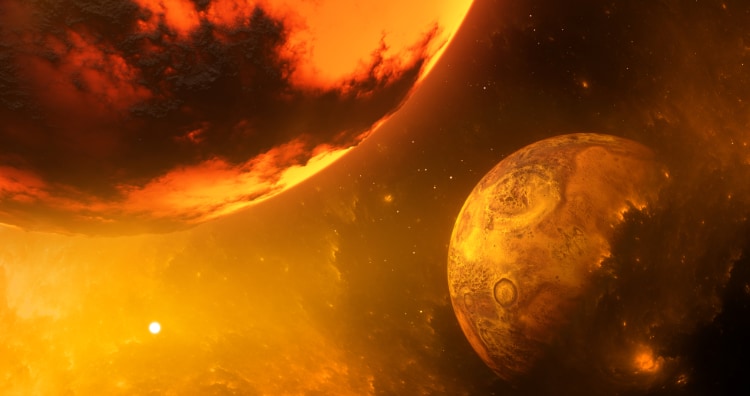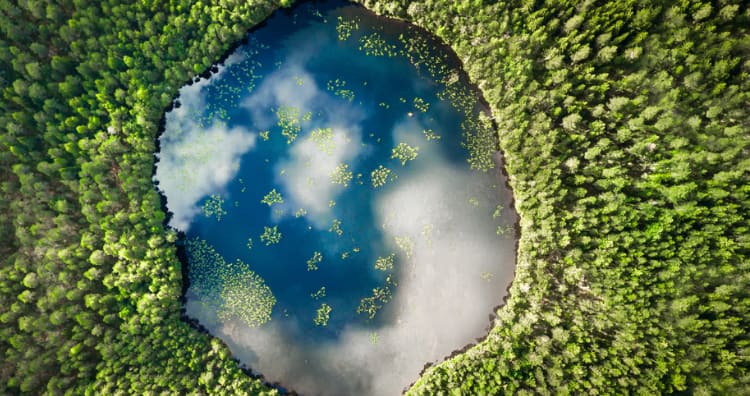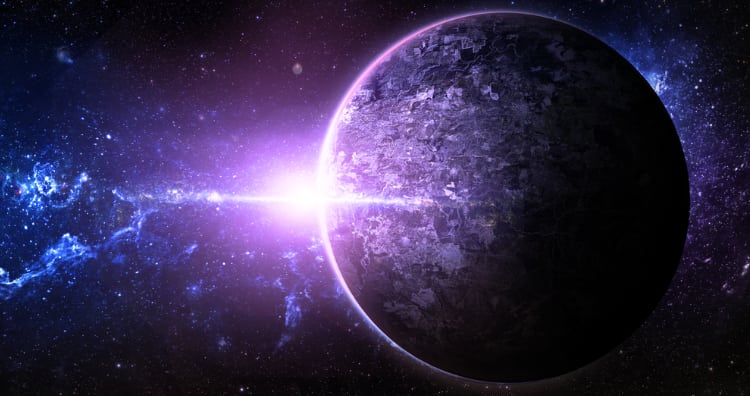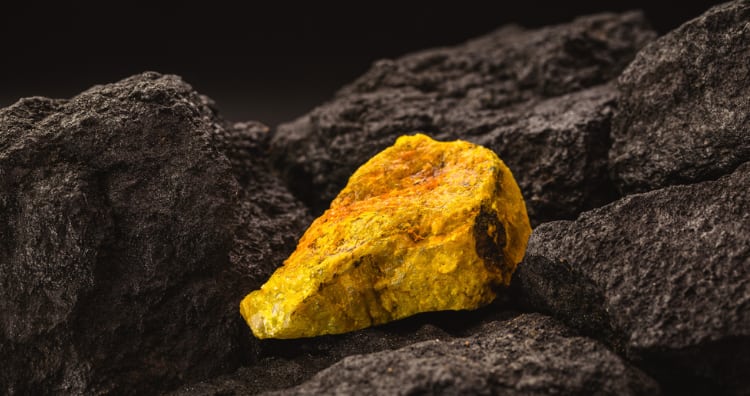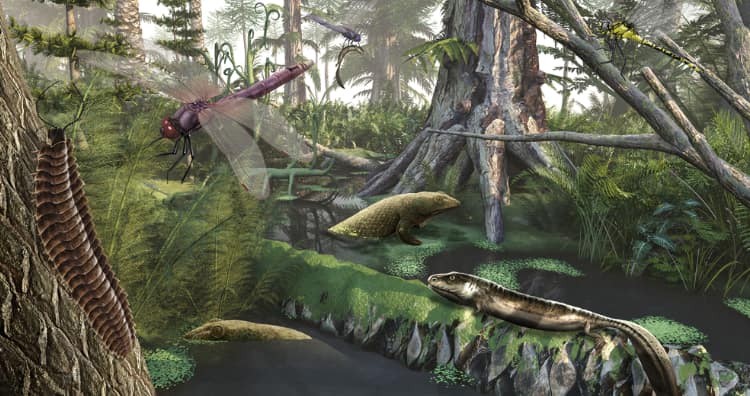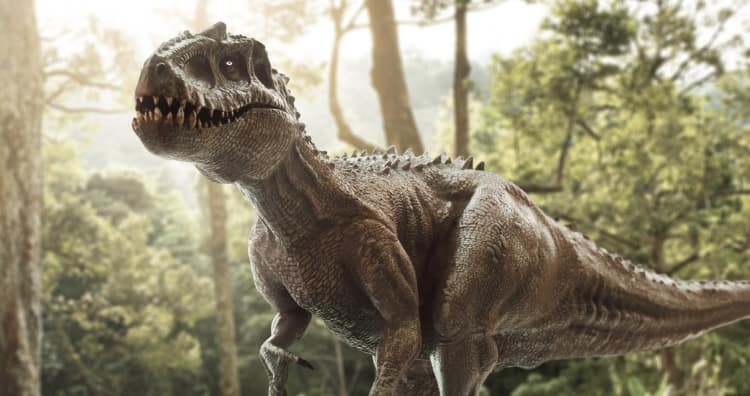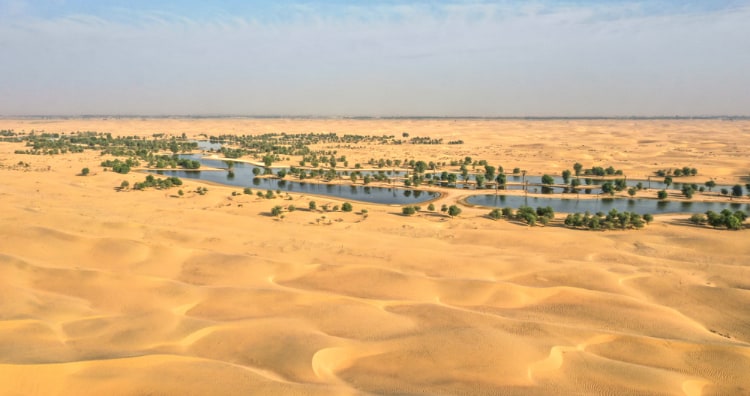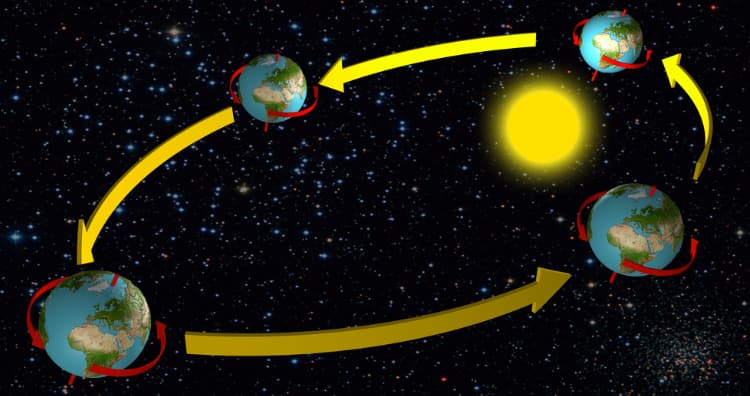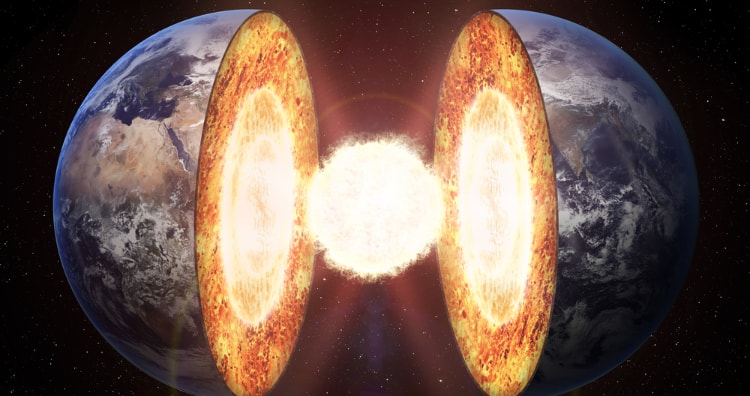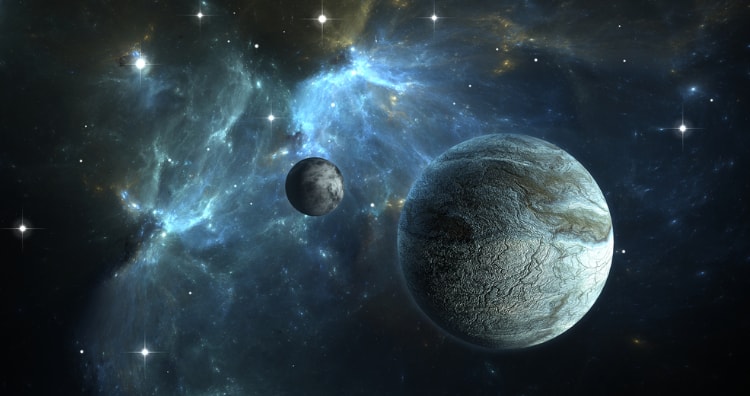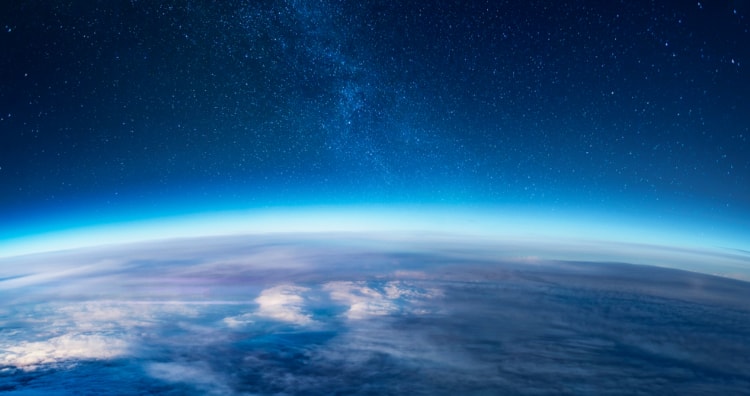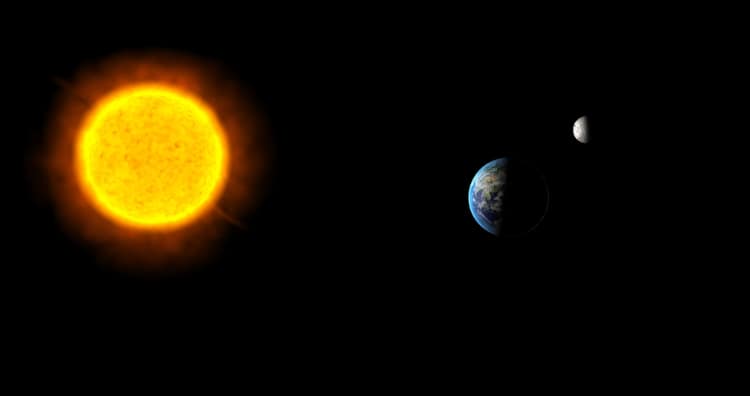71 Interesting Facts About the Earth
Thanks to our wonderful spirit of inquisitiveness, we have discovered numerous amazing things about our home planet. So, here are some of the most interesting facts about the Earth!
Table of Contents
1/71
An ancient planet called “Theia” may have collided with the Earth about 4.5 billion years ago.
This collision could then have broken off a rock chunk that became our moon. Now, research suggests that the (massive) remains of this protoplanet may be buried deep inside the Earth.
2/71
All current life forms on Earth likely have a common ancestor from which they descended.
This common ancestor is a population of organisms called the Last Universal Common Ancestor (LUCA). It was likely a single-celled organism that existed about 4 billion years ago. However, LUCA is not believed to be the first life on Earth. It is simply the most recent common ancestor of all present life on the planet.
3/71
More than 3 billion years ago, the Earth was probably a “water world” with a global ocean and almost no land.
Scientists analyzed the levels of two oxygen isotopes, oxygen-16 and oxygen-18, in an ancient slab of oceanic crust to see what imprints it carries from its surrounding environment. They then found that when the crust formed about 3.2 billion years ago, there was more oxygen-18 in the seawater. This suggests there were almost no continents around because had the continents been present, they would have absorbed the oxygen-18 isotope.
4/71
The early Earth may have been purple in color.
Most photosynthesizing organisms today are chlorophyll-based, a compound that reflects green light. But early photosynthesizing life forms may have been retinal-based, which is a compound that appears purple. As a result, the Earth, too, may have been purple. This is known as the Purple Earth hypothesis.
5/71
The early Earth had almost no oxygen in its atmosphere.
Some 2.4 billion years ago, the oxygen levels began to change, leading to what is called the Great Oxidation Event. But according to a new study, oxygenation of the atmosphere actually fluctuated for about 200 million years. This then pushes the period of permanent oxygenation of the planet to about 100 million years later than previously thought.
6/71
Long before humans ever did, the Earth created its own nuclear reactor in Africa.
In Oklo, a region in the African country of Gabon, researchers discovered uranium ore that contained less U-235 than most natural uranium. After analyzing it, they found that this ore had naturally undergone nuclear fission about 2 billion years ago, making it a natural nuclear reactor.
7/71
The so-called “Boring Billion” is a period in Earth’s history that was characterized by relatively few geological events.
This period spanned between 1.8 and 0.8 billion years ago and was largely characterized by geological, evolutionary, and climatic stability.
8/71
The Earth once had giant organisms called Prototaxites on it.
https://twitter.com/daisylafarge/status/1389884267510083586
These may have lived around 420 to 350 million years ago and were likely fungi. As deduced from their fossils, these could grow up to 24 feet (eight meters) in height and three feet (one meter) in width.
9/71
During its Carboniferous period, the Earth had giant insects on it.
About 300 million years ago, oxygen levels on Earth were high – more than 30 percent of the atmosphere as opposed to 21 percent today. This then likely allowed creatures to become large. So, giant dragonfly-like creatures with wingspans of up to 28 inches (about 71 centimeters) were able to exist.
10/71
From about 300 to 200 million years ago, Earth’s continents were arranged as a huge “supercontinent” surrounded by a single enormous ocean.
This supercontinent was called Pangaea, and the ocean was called Panthalassa. Some evidence of this is seen in how continents seem to fit together as a puzzle. Scientists have also found identical rocks and dinosaur fossils on different continents, supporting this theory. Interestingly, before Pangaea, there were other supercontinents too, such as Rodinia and Nuna. Supercontinents have likely formed and broken up a few times in the past!
11/71
The Earth has a hidden eighth continent.
It is called Zealandia and is about six times the size of Madagascar. This piece of land broke off from the supercontinent Gondwana about 83 to 79 million years ago and later sank. Today, most of it lies submerged in the Pacific Ocean, with just some parts sticking out, like New Zealand and New Caledonia.
12/71
Billions of Tyrannosaurus rex dinosaurs have likely roamed Earth over a period of 2 million years.
In a recent calculation, researchers used an estimate of the range of T. rex dinosaurs across present-day North America and combined this with the animal’s body mass. They then concluded that there would have been about 20,000 individuals alive on the planet at any one time. This then means that there were about 2 billion of them over a period of 2 million years for the entirety of the species’ existence.
13/71
In Canada’s Hudson Bay, people weigh less than in the rest of the world due to an anomaly in the Earth’s gravity.
About 20,000 years ago, much of North America was covered by a massive glacier called the Laurentide Ice Sheet. Due to its crushing weight, the rock underneath compressed and sank, displacing the Earth’s mantle layer. This effect was most prominent in regions around Hudson Bay, Canada, where the ice had formed two huge domes. So, the Earth likely retained the echoes of the glacial domes, leading to the lower gravitational field in the region. There is also a higher-than-average mantle seismic velocity in the area, which could also be contributing to this anomaly.
14/71
The Earth’s shifting axis likely causes the Sahara to swing between wet and dry climates every 20,000 years.
Researchers at the Massachusetts Institute of Technology analyzed dust deposits off the coast of West Africa over the past 240,000 years. They then found that because of the Earth’s shifting axis as it orbits around the Sun, the Sahara and North Africa in general, cycle between wet and dry climates every 20,000 years. According to this, the Sahara was likely more “green” in the past before switching to the drier climate seen there today.
15/71
The name “Earth” means “the ground,” and we may never know who named it.
Most planets in the Solar System were named after Roman and Greek deities. But our planet’s name is at least a thousand years old and is a Germanic word that means “the ground.” So, even if a single person did name it, their identity is unknown.
16/71
The first-ever photographs of the Earth from space were captured in 1946.
These pictures were captured on 24 October 1946, by a 35-millimeter motion picture camera launched on a V-2 missile.
17/71
The first Earth Day was observed in 1970.
Earth Day is celebrated every year on 22 April. The first Earth Day was observed on 22 April 1970. This day is an annual event that signifies support for environmental protection.
18/71
Earthquakes in the past may have shifted the Earth’s figure axis.
Earth’s figure axis is the axis about which its mass is balanced. According to NASA, the 2004 Sumatran earthquake (magnitude 9.1) should have shifted the Earth’s figure axis by 2.76 inches. The 2010 Chile earthquake (magnitude 8.8) and the 2011 earthquake in Japan (magnitude 9.0) should have had similar effects.
19/71
The Earth is witnessing the birth of a new ocean in Africa.
In about five to 10 million years, the African continent will split apart and give rise to a new ocean. A crack 60 kilometers long (about 35 miles) opened up in Ethiopia in 2005 and has been said to be expanding since.
20/71
Our planet is home to numerous species, but we have yet to identify most of them.
Estimates of the number of species on Earth vary. According to a 2011 estimate, there were about 8.7 million species (excluding bacteria and a few other micro-organisms) on Earth, but a vast majority of them were undocumented. Another study from 2016 estimated that there were one trillion microbial species on the planet.
21/71
Earth’s core may be as hot as the Sun’s surface.
In a 2013 study, researchers estimated the melting point of iron in a laboratory at high precision. Then, using this data, they found that temperatures in the Earth’s iron-rich core (at its inner core boundary) could reach about 6,000 K. This is roughly as hot as the Sun’s surface!
22/71
An interstellar object may have exploded over the Earth in 2014.
On 8 January 2014, a rock from space streaked across the sky off the coast of Manus Island, Papua New Guinea. This rock, however, was believed to be unusual due to its high speed in the Earth’s atmosphere, suggesting that it may have had an interstellar origin. This incident was confirmed in 2022 in a declassified data set.
23/71
Earth may have an underground water reservoir three times of what’s in the oceans.
According to a 2014 study, researchers concluded that the Earth’s mantle transition zone acts as a vast water reservoir. However, all this water is locked up about 400 miles under the surface inside a mineral called Ringwoodite. Ringwoodite acts as a sponge that attracts hydrogen, causing it to trap water. The study used data from a network of seismometers across the US, along with lab experiments that simulated the high pressures deep underground.
24/71
Earth might not be the most habitable planet out there.
In 2015, Wired UK reported that a new index had been developed to help researchers see which exoplanets could support life. According to this, the exoplanet Kepler-442b has a rating of 0.836, while Earth has only 0.829, making the former more habitable.
25/71
Rising carbon dioxide levels are making the Earth greener.
According to NASA in 2016, vegetated lands on Earth had significant greening, mostly due to rising carbon dioxide levels. As we know, green-leafed plants use sunlight and carbon dioxide during photosynthesis. So, when carbon dioxide concentration increases, it increases photosynthesis and plant growth. However, this does not mean that the rise of carbon dioxide levels is good because it still affects climate change.
26/71
Humans account for just 0.01 percent of the Earth’s life, but plants represent 82 percent of all living things.
Despite this, the 2018 report reveals that humans have wiped out about 83 percent of wild mammals and half of plants. The estimate also states that only four percent of the world’s mammals are wild, while the rest are humans and livestock.
27/71
The ozone layer has a “hole” over the Antarctic that grows and shrinks every year.
The discovery of this ozone hole was a major reason for the phasing out of ozone-depleting chemicals in the 1980s. But in 2019, NASA reported that the hole had shrunk to its smallest since its discovery. This was caused by warmer temperatures in the stratospheric layer over Antarctica and seems unrelated to climate change. However, this does not mean the ozone hole is suddenly on a fast track to recovery.
28/71
The Earth’s oceans are teeming with viruses.
According to a 2019 study, there are almost 200,000 virus populations in the oceans, which is 12 times more than previously known! Although most of these viruses are probably harmless to humans, they could still affect marine organisms. Viruses can also have an impact on the plankton in the oceans that produce most of our oxygen.
29/71
Earth’s days often vary in length.
The Earth’s day has been noted to be increasing in length by about 1.7 milliseconds a century due to the Moon slowing its rotation down with the tides it helps create. But in 2020, the Earth was reportedly spinning faster, with 28 of its fastest days (since 1960) being from that year.
30/71
The Earth has a mass of 5.97 x 1024 kilograms.
It is also the densest planet in the Solar System.
31/71
The circumference of Earth around the equator is 24,901 miles (40,075 kilometers).
But from pole to pole, the circumference is only 24,860 miles (40,008 kilometers). This slight difference is due to the Earth’s rotations, which causes it to flatten at the poles and bulge at the equator. This then gives the Earth its “oblate spheroid” shape.
32/71
The Earth rotates at about 1,037 mph (1,670 kph) at the equator.
Its revolutions, however, happen at about 67,000 mph (107,000 kph). That’s nearly a thousand times faster than a typical car!
33/71
The Earth’s crust is just one percent or less of the planet’s size.
The “crust” is the outermost shell of terrestrial planets. On Earth, the crust is about 25 miles (40 kilometers) deep, just one percent (or less) of the planet’s size. Yet, it helps support all known life in the universe.
34/71
The Moon is 400 times smaller than the Sun but is also about 400 times closer to the Earth.
As a result, the Sun and the Moon appear to be roughly the same size in the sky. This is also why total solar eclipses are possible, despite the Sun being much larger.
35/71
If the Moon came closer than about 12,000 miles to the Earth, it would disintegrate.
This is the Earth’s Roche limit. This limit gives the distance within which the gravitational field of one object or planet is so strong that it causes a second object to disintegrate. The disintegrated body would then form a ring around the first object.















